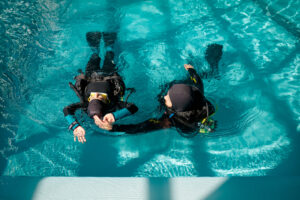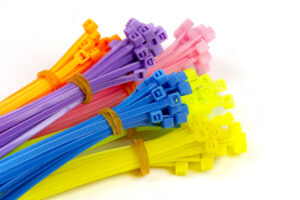What is a Net Cutter?
A net cutter is a vital tool used by scuba divers to navigate underwater environments safely. This tool is specifically designed to cut through fishing nets, lines, and other entangling materials that may pose a threat to divers and marine life. The use of net cutters is crucial in emergency situations where quick action is required to free a trapped diver or animal. Net cutters are not only essential for personal safety but also play a significant role in environmental conservation by aiding in the removal of abandoned nets, which are harmful to underwater ecosystems.
History and Development of Net Cutters
The concept of the net cutter has been around as long as there have been underwater obstructions posing risks to divers. In the early days of scuba diving, entanglements with fishing nets and lines were common, leading to the development of simple cutting tools to address this problem. These early tools were often rudimentary, improvised from available materials and lacking in efficiency.
As scuba diving evolved into a more widespread and organized activity, the need for more specialized equipment became apparent. The development of net cutters followed, with innovations aimed at improving their effectiveness and reliability. During the 1970s and 1980s, as recreational diving grew in popularity, manufacturers began producing dedicated net cutters made from corrosion-resistant materials suitable for underwater use.
The design of net cutters has continuously evolved, incorporating new materials and ergonomic improvements. Modern net cutters are often made from high-grade stainless steel or titanium, ensuring durability and resistance to rust. The handles have also been enhanced to provide a secure grip, even when used with gloves in wet conditions. Notable inventors and companies in the diving industry have contributed to the advancement of net cutter technology, making these tools more efficient and safer for divers worldwide.
Types of Net Cutters
Net cutters come in various types, each designed to cater to different needs and preferences of divers. One of the most common types is the folding net cutter. This type is compact and can be easily stored in a pocket or attached to a diving suit. When needed, the blade can be unfolded and locked into place, ready for use. Folding net cutters are favored for their portability and convenience, making them a popular choice among recreational divers.
Another prevalent type is the fixed blade net cutter. Unlike the folding variant, the fixed blade net cutter has a permanently extended blade, offering greater rigidity and reliability. These cutters are typically stored in a sheath that can be mounted on the diver’s equipment for easy access. Fixed blade cutters are often preferred by professional and technical divers who require a robust tool that can withstand heavy use.
The materials used in the construction of net cutters also vary. Stainless steel is commonly used due to its strength and resistance to corrosion. Titanium is another popular material, known for being lightweight and highly durable, though it tends to be more expensive. Some net cutters feature serrated edges designed to saw through thicker ropes and lines, while others have straight edges for cleaner cuts.
Each type of net cutter has its advantages and limitations. Folding net cutters are excellent for their compactness and ease of storage, but they may not be as durable as fixed blade cutters. Fixed blade cutters, on the other hand, offer superior strength but require more space for storage. Divers must consider their specific needs and diving conditions when choosing the right type of net cutter.
Net Cutter Usage in Scuba Diving
Net cutters are indispensable tools in various underwater scenarios, ensuring the safety of divers and the protection of marine life. One of the most common uses of net cutters is to free divers who become entangled in fishing nets or lines. In such situations, the ability to quickly and efficiently cut through the entangling material can be the difference between life and death. Divers often carry net cutters as part of their standard equipment, ready to be deployed in emergencies.
Using a net cutter underwater requires a clear understanding of its operation and safety protocols. The first step is to remain calm and assess the situation. Panic can lead to poor decisions and increase the risk of injury. Once the entanglement is identified, the diver should carefully retrieve the net cutter and position it at the point where the net or line can be cut without causing additional harm. It is crucial to ensure that the blade is oriented correctly to make a clean cut and to avoid damaging the diver’s suit or equipment.
In addition to emergency situations, net cutters are also used in conservation efforts. Divers involved in marine conservation projects often encounter abandoned fishing nets, known as ghost nets, which pose significant threats to marine life. These nets can trap fish, turtles, and other sea creatures, leading to injury or death. By using net cutters, divers can safely remove these hazardous nets, contributing to the health and preservation of underwater ecosystems.
There are numerous documented cases where net cutters have been critical. For instance, during a routine dive, a group of divers encountered a dolphin entangled in a discarded fishing net. Using their net cutters, they carefully freed the dolphin, allowing it to swim away unharmed. Such incidents highlight the importance of net cutters as life-saving tools in the diving community.
Safety Guidelines
Safety is paramount when handling and using net cutters underwater. Divers must follow specific protocols to ensure their well-being and the effective use of these tools. One key guideline is to always carry a net cutter as part of the standard diving kit. This ensures that the tool is readily available in case of an emergency.
Proper maintenance of net cutters is essential to keep them in working condition. After each dive, the cutter should be rinsed with fresh water to remove salt and other residues that could cause corrosion. Regularly checking the blade for sharpness and any signs of wear is also important. A dull or damaged blade can hinder its effectiveness, making it more difficult to cut through tough materials.
Divers should also be aware of the legal and ethical considerations associated with using net cutters. In some regions, there are regulations governing the removal of fishing nets and other underwater obstructions. It is important to adhere to these regulations to avoid legal repercussions and to ensure that the removal of nets does not disrupt marine habitats. Ethical considerations include ensuring that the removal of nets is done in a way that minimizes harm to marine life and does not contribute to further environmental degradation.
Another important aspect of safety is proper training in the use of net cutters. Divers should receive instruction on how to handle and operate these tools effectively. Training often includes practicing on simulated entanglements to develop the skills needed to use the net cutter safely and efficiently. Familiarity with the tool and confidence in its use can significantly reduce the risk of accidents during real-life situations.
Impact on Marine Life and Environment
Net cutters play a crucial role in protecting marine life and preserving underwater environments. One of the primary benefits of these tools is their ability to prevent fatalities among marine animals. Abandoned fishing nets, often referred to as ghost nets, continue to trap and kill marine creatures long after they have been discarded. By removing these nets, divers can save countless animals from a slow and painful death.
The impact of ghost nets on coral reefs is particularly damaging. When these nets settle on coral formations, they can cause physical damage, breaking off pieces of the coral and hindering their growth. Net cutters enable divers to remove these threats, allowing coral reefs to recover and thrive. The preservation of coral reefs is essential, as they provide habitat for a diverse array of marine species and play a critical role in maintaining the health of ocean ecosystems.
In addition to direct benefits for marine life, the use of net cutters contributes to broader environmental conservation efforts. The removal of ghost nets helps to reduce marine debris, which is a significant problem in oceans worldwide. Marine debris not only poses a threat to wildlife but also affects water quality and the overall health of marine environments. By actively participating in net removal, divers are taking an important step in addressing this issue.
While the positive impacts of net cutters are clear, it is also important to consider the balance between human activities and marine conservation. Divers must be mindful of their actions and ensure that the removal of nets is done responsibly. This includes avoiding unnecessary disturbance to marine habitats and being aware of the potential impact on local ecosystems. Responsible use of net cutters can maximize their benefits while minimizing any negative effects on the environment.
Technological Advancements and Future Prospects
The field of net cutter technology continues to evolve, with ongoing research and development aimed at improving their effectiveness and safety. One area of advancement is the integration of more durable and lightweight materials. Titanium and advanced composites are being explored to create net cutters that are both strong and easy to handle underwater. These materials offer the potential for longer-lasting tools that require less maintenance.
Another promising development is the incorporation of ergonomic designs that enhance the ease of use. Modern net cutters are being designed with handles that provide better grip and control, even when wearing thick diving gloves. This focus on user-friendly design helps to ensure that net cutters can be operated efficiently in high-stress situations.
Future innovations may also include the integration of cutting-edge technologies such as smart sensors. These sensors could provide divers with real-time feedback on the condition of the blade, alerting them when it needs sharpening or replacement. Such advancements would contribute to the reliability and safety of net cutters, making them even more indispensable for divers.
The continued advancement of net cutter technology holds great promise for the future. As new materials and designs are developed, net cutters will become more efficient, durable, and easier to use. This will enhance their role in ensuring diver safety and protecting marine environments, reinforcing their importance in the diving community.
Key Takeaways
Net cutters are essential tools in the scuba diving community, playing a critical role in ensuring diver safety and protecting marine life. Their development has evolved significantly, incorporating advanced materials and ergonomic designs. Various types of net cutters are available, each suited to different needs and scenarios. Proper usage and maintenance are crucial for their effectiveness, and they have a profound impact on marine conservation efforts. Technological advancements continue to improve their functionality, promising even greater benefits in the future.

















